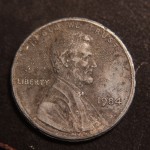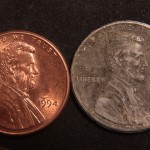We are seeing more and more of these cents with stripped plating that have a larger-than-normal diameter. I decided to post a thread about this, hoping for some more input and discussion about this little mystery. After doing some more research and experimentation, I decided I needed to edit this glossary entry as well. I currently surmise that the exposure of the cent to harsh acids, chemicals, and heat during the stripping process is also causing this distortion of the zinc core, rather than it being from mechanical means. If you have any insight on what may be happening here, please discuss. I'd surely like to get Thad's input on this. He surely would have some insight here. Here is how the entry reads now:
Texas Cent: A cent with a larger-than-normal diameter that was intentionally damaged outside the mint. The traditional method is hammering the cent between pieces of (usually) leather. However, another instance of cents with larger-than-normal diameters is now commonly seen on cents that have had their plating removed. Whatever methods are being used to strip the plating, most of which involve exposure to chemicals and heat, are leaving the resulting zinc core thinner with an expanded diameter. I am still trying to investigate exactly how this is happening. Below is an example of one of these stripped cents. Photos courtesy of jallengomez.


Texas Cent: A cent with a larger-than-normal diameter that was intentionally damaged outside the mint. The traditional method is hammering the cent between pieces of (usually) leather. However, another instance of cents with larger-than-normal diameters is now commonly seen on cents that have had their plating removed. Whatever methods are being used to strip the plating, most of which involve exposure to chemicals and heat, are leaving the resulting zinc core thinner with an expanded diameter. I am still trying to investigate exactly how this is happening. Below is an example of one of these stripped cents. Photos courtesy of jallengomez.





 Thanks for the update... It is fun to test out theories... Not only that it can answer lots of questions and create new ones... Could it be that these Texas cents were flattened first then had the plating removed electrically???
Thanks for the update... It is fun to test out theories... Not only that it can answer lots of questions and create new ones... Could it be that these Texas cents were flattened first then had the plating removed electrically???
 Be verwy verwy quiet... I'm hunting coins!!!
Be verwy verwy quiet... I'm hunting coins!!! 

Comment